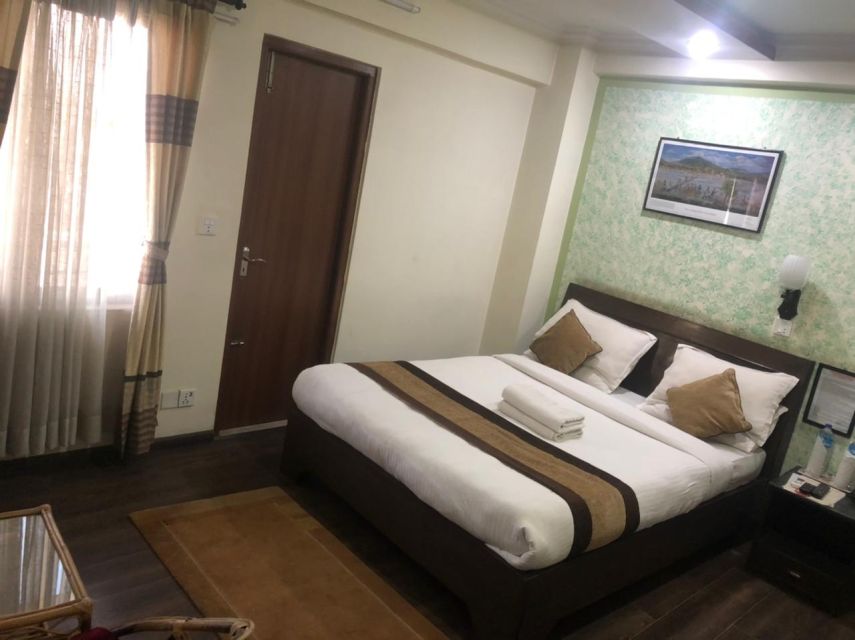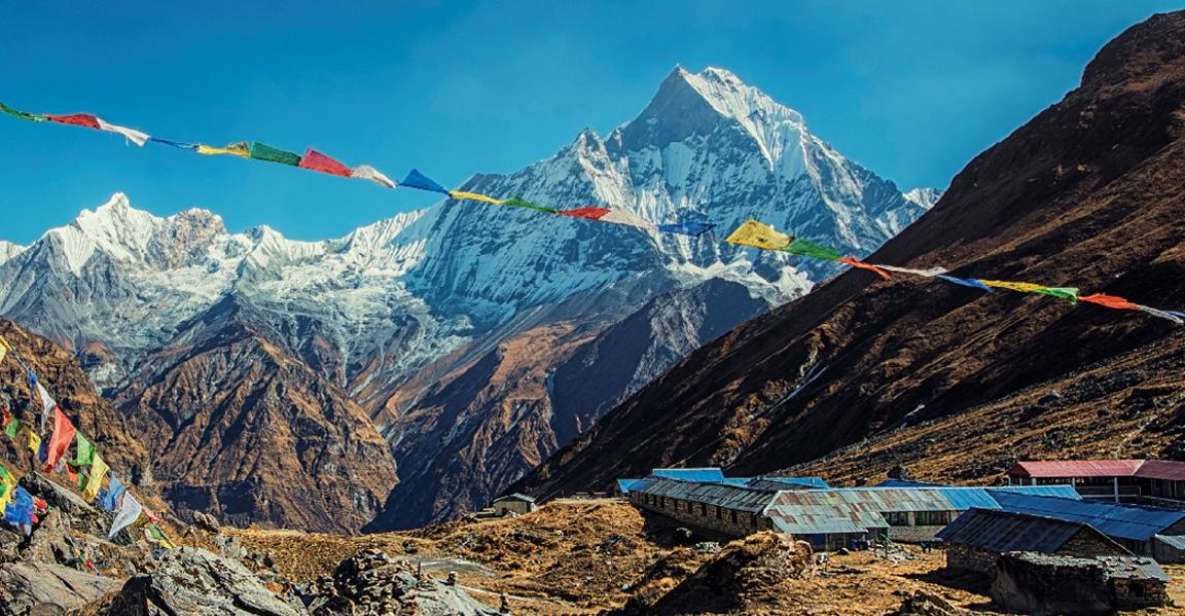When someone considers the 11-Day Annapurna Base Camp Trek from Kathmandu, they’re not just signing up for a physical challenge; they’re also stepping into a vibrant tapestry of culture and breathtaking scenery. With daily treks averaging 5-6 hours, trekkers can savor the stunning landscapes while seeing the daily lives of local villagers. Cozy teahouses provide a welcoming retreat after a day of exploration, but there’s more to this journey than just the views and accommodations. Curious about what essential items make the trek smoother and which permits are necessary?
Key Points

- The trek begins in Kathmandu, followed by a scenic flight to Pokhara, before starting the Annapurna Base Camp journey.
- The 11-day itinerary includes daily treks of 5-6 hours, traversing diverse terrains and offering stunning mountain views.
- Accommodations consist of 3 nights in 2-star hotels and 7 nights in local teahouses, with all meals provided during the trek.
- Essential permits, such as the Annapurna Conservation Area Permit and TIMS card, are required and can be arranged in Kathmandu or Pokhara.
- Best trekking seasons are autumn (September-November) and spring (March-May) for optimal weather and vibrant scenery.
It's also worth checking out some other tours and experiences nearby.
Trek Overview

The Annapurna Base Camp Trek offers adventurers an unforgettable journey through stunning landscapes, leading them right to the foot of the majestic Annapurna I.
Over 11 days, trekkers experience everything from lush forests and cascading waterfalls to quaint villages filled with local culture. It’s not just about the breathtaking views; it’s also about meeting friendly locals and savoring authentic Nepali cuisine.
The trek begins in Kathmandu, where travelers can soak in the vibrant atmosphere before flying to Pokhara.
With a mix of challenging trails and scenic paths, this trek is suitable for those with moderate fitness levels.
Travelers should pack wisely, wearing comfortable shoes and layers to adapt to changing weather conditions.
Detailed Itinerary
Kicking off the adventure, trekkers will first arrive in Kathmandu, where they can enjoy the local culture before embarking on the journey to Annapurna Base Camp. The detailed itinerary includes a mix of stunning landscapes and charming villages, making each day exciting and unique.
-
Explore vibrant Kathmandu with its rich history and delicious cuisine.
-
Experience breathtaking views of the Annapurna mountain range.
-
Trek through diverse terrains, from lush forests to rocky trails.
-
Enjoy the warmth of local teahouses and the camaraderie of fellow trekkers.
With each day’s trek averaging 5-6 hours, trekkers will build not just endurance, but also unforgettable memories along the way.
Inclusions and Amenities
Inclusions and amenities on the Annapurna Base Camp Trek ensure trekkers enjoy both comfort and convenience, making the adventure as enjoyable as possible.
Participants can look forward to cozy accommodations, with three nights in 2-star hotels in Kathmandu and Pokhara, plus seven nights in welcoming teahouses along the trek.
All meals during the trek, along with a warm welcome and farewell dinner, are included to keep everyone fueled for the journey.
Ground transportation is covered by a private vehicle, and domestic flights connect Kathmandu and Pokhara seamlessly.
An experienced English-speaking trek leader and porter service make the trek smoother, while essential equipment like a down jacket and sleeping bag are provided.
Plus, all necessary permits and medical support are handled for peace of mind!
Best Seasons to Trek
Opting for the right season can transform the Annapurna Base Camp Trek into an unforgettable experience, with autumn and spring offering the best conditions for stunning views and pleasant weather.
-
Autumn (September-November): Enjoy clear skies and vibrant landscapes.
-
Spring (March-May): Witness blooming rhododendrons and mild temperatures.
-
Winter (December-February): Experience solitude, but prepare for frigid conditions.
-
Monsoon (June-August): Expect heavy rain, making trails slippery and less accessible.
Choosing between these seasons can greatly affect not just the trek’s beauty but also the overall enjoyment.
Trekking during autumn or spring allows trekkers to embrace the breathtaking scenery while engaging with the local culture, making every step of the journey memorable.
Required Permits
When planning the Annapurna Base Camp Trek, trekkers need to secure specific permits to ensure a smooth journey through this stunning region.
The two essential permits are the Annapurna Conservation Area Permit (ACAP) and the Trekkers’ Information Management System (TIMS) card. ACAP helps protect the natural beauty and cultural heritage of the area, while TIMS ensures trekkers’ safety and provides valuable data for local authorities.
Getting these permits is straightforward; trekkers can arrange them through trekking agencies in Kathmandu or Pokhara.
It’s wise to budget a little extra time for this process, as it adds to the overall experience by connecting trekkers with local culture and customs.
Customer Experiences
Many trekkers rave about their unforgettable experiences on the Annapurna Base Camp Trek, highlighting the breathtaking landscapes and the warmth of local hospitality. They often share stories that resonate with adventure and discovery:
-
The awe of standing beneath towering peaks like Annapurna I.
-
Shared meals with friendly locals, learning about their culture.
-
Encounters with fellow trekkers from around the globe, fostering lasting friendships.
-
The sense of achievement upon reaching the base camp after days of trekking.
These experiences not only create cherished memories but also deepen one’s appreciation for Nepal’s rich culture and stunning nature.
Trekkers often leave feeling transformed, eager to return and explore more of what this beautiful region has to offer.
Essential Packing List
To ensure a comfortable and enjoyable trek to Annapurna Base Camp, it’s crucial to pack wisely, balancing essentials with lightweight gear suited for the diverse terrains and changing weather conditions.
Start with sturdy trekking boots and moisture-wicking clothing, as the trails can be rugged and conditions unpredictable. Don’t forget a good quality down jacket and thermal layers for those chilly nights.
A lightweight sleeping bag and trekking poles can make a significant difference too. Pack a refillable water bottle and snacks to keep your energy up.
A hat, sunglasses, and sunscreen will protect against the sun’s glare at higher altitudes. Lastly, keep a small first-aid kit handy, as it’s always better to be prepared for minor mishaps.
Travel Tips and Recommendations
Packing for the Annapurna Base Camp Trek requires careful consideration of both the essentials and the unique challenges posed by the Himalayan environment. To make the trek enjoyable and safe, travelers should keep these tips in mind:
-
Layer clothing to adapt to changing temperatures.
-
Keep snacks handy for energy boosts during long days.
-
Stay hydrated; carry a reusable water bottle with purification tablets.
-
Respect local customs; learn a few basic Nepali phrases.
Staying flexible with plans can enhance the experience, as weather conditions may change unexpectedly.
Embracing local culture and engaging with fellow trekkers adds a rich layer to the adventure.
With the right preparation, trekkers can truly enjoy the breathtaking landscapes and vibrant communities along the route.
Here's a few more nearby tours and experiences we think you'll like.
Frequently Asked Questions
What Level of Fitness Is Required for the Trek?
For this trek, a moderate fitness level’s required. Participants should enjoy hiking, be prepared for steep ascents, and acclimatize to higher altitudes. Regular training before the trek can greatly enhance their experience and enjoyment.
Are There Any Age Restrictions for Participants?
There aren’t strict age restrictions for participants, but trekkers should be physically fit. Generally, those aged 12 to 65 can join comfortably. It’s best to consult with the trek organizer for specific recommendations.
Can Dietary Restrictions Be Accommodated During the Trek?
Yes, dietary restrictions can be accommodated during the trek. Participants should inform the trek leader about their needs ahead of time, ensuring everyone enjoys delicious meals tailored to their preferences while experiencing Nepal’s rich culinary culture.
Is Travel Insurance Necessary for This Trek?
Travel insurance’s essential for trekkers. It covers unexpected events like cancellations or medical emergencies. Plus, it gives peace of mind while exploring Nepal’s stunning landscapes. They shouldn’t overlook this important aspect of travel preparation.
What Communication Facilities Are Available During the Trek?
During the trek, communication facilities are limited. Trekkers can rely on mobile phones in some areas, but Wi-Fi is scarce. It’s wise to inform others before departing, ensuring no one worries during the adventure.
Not for you? Here's more of our most recent tour reviews happening neaby
- Kathmandu: 5 Days Pokhara & Chitwan Jungle Safari Tour
- 3 Nights Chitwan Jungle Adventures From Kathmandu
- 4 Days Chitwan National Park Tour With Tower Night Stay
- 2 Night 3 Day Pokhara Tour With Sunrise From Sarangkot
- Nagarkot Sunrise and 7 World Heritage Tour in Kathmandu
- Cultural Tour With Chitwan Jungle Safari
- Everest Mountain Flight
- Everest Mountain Flight: Scenic Adventure From Kathmandu
- Pokhara: 8-Day Unforgettable Annapurna Base Camp Trek Tour
- Everyday Mountain Flight
- Langtang Valley Trek
- Discover Ghandruk & Poonhill Circuit 3-Day Trek From Pokhara
- Kathmandu to Pokhara: One Way Private Transfer
- Kathmandu: Monsoon Magic! Eat, Explore, Capture the Rain
- From Kathmandu: 1 Night 2 Days Kalinchowk Jeep Tour
Recap
The 11-day Annapurna Base Camp Trek is more than just a journey; it’s an unforgettable experience that blends adventure, culture, and stunning scenery.
As trekkers navigate through vibrant villages and majestic landscapes, they’ll create lasting memories and connections with the local culture.
With the right preparation and the ideal season, anyone can embrace the beauty of this trek.
So lace up those hiking boots and get ready for an adventure of a lifetime in the heart of Nepal!
